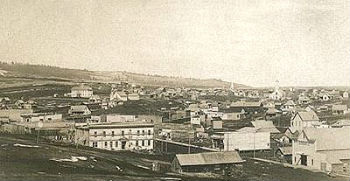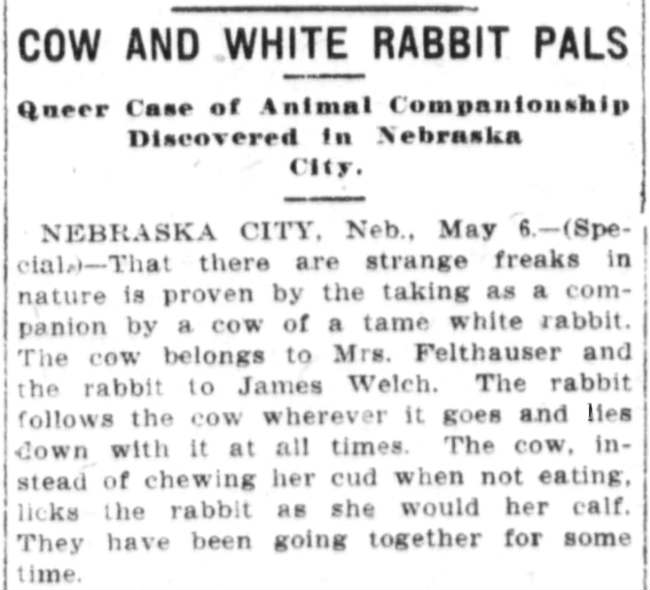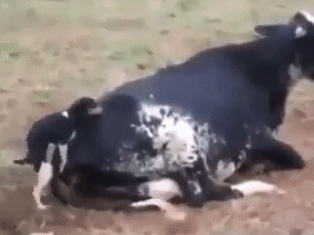Rabbit-cow Hybrids?
Mammalian Hybrids
 Cottonwood, Idaho, early 1900s
Cottonwood, Idaho, early 1900s
Caution: Though repeatedly reported, the occurrence of this distant cross has not been confirmed via the genetic testing of an actual specimen.
Although they sound like fairy-tale creatures, rabbit-cow hybrids and hare-cow hybrids, have in fact been described in the nonfictional context of serious news reports. Some were even described as living animals that promised to reach maturity.
Thus, the following article about an ostensible rabbit-cow hybrid appeared in the Cottonwood, Idaho, newspaper Camas Prairie Chronicle, (Feb. 26, 1904, p. 1, cols. 5 & 6):
CALF WITH A RABBIT HEAD
A large crowd of people viewed a freak of nature here [i.e., in Cottonwood, Idaho] Saturday in the shape of a one-legged calf with a head like a rabbit† which one of the Denham boys was taking home to his farm near Keuterville. The calf, which was born in a pasture near here, had one perfect hind leg and two short front legs, each about 5 or 6 inches long. One had a small foot resembling a rabbit foot and the other had neither foot nor hoof.§ The calf’s nose was round and the lips full making its head resemble that of a rabbit much more than that of a calf. It looked quite strong in spite of its odd condition and with proper care might live to occupy a place in a freak museum.
§ Stump appendages, and appendages that are entirely absent, seem to occur at elevated rates in the progeny of distant crosses, no doubt due to developmental conflicts resulting from the random combination of highly disparate genomes.
The following report, which originated with the Fayette County Record, a newspaper published in the town of Washington Court House, Ohio, is here taken from the Hillsboro, Ohio, News-Herald (Aug. 18, 1901, p. 1, col. 2; ||y6m7rf66 ):
A RABBIT CALF
There are two lagomorphs native to Ohio the Eastern cottontail, Sylvilagus floridanus and the Snowshoe hare, Lepus americanus. Since the latter does not occur in Fayette County, the former would be the parent implicated, if the animal described in report just quoted does represent a cow-rabbit hybrid.
From the Bloomsburg, Pennsylvania, Columbian (Apr. 4, 1901, p. 4, col. 3):
From the St. Albans, Vermont, Messenger (May 2, 1907, p. 2, col. 1):
Another report about a rabbit-cow hybrid appeared in the Troy, Missouri, Herald (Jul. 30, 1873, p. 5, col. 1):
The following is from an Australian newspaper, The Gosford Times and Wyong District Advocate (Oct. 5, 1922, p. 13):
EXTRAORDINARY FREAK
In this last-quoted case, the close-set positioning of the eyes may represent a mild form of cyclopia. The incidence of cyclopia seems to be elevated in distant hybrids, as is the misplacement of appendages.
Another such report appeared on page 5, column 3, of the November 23, 1911, issue of the Austro-Hungarian newspaper Linzer Volksblatt:
It might seem impossible for a hare or rabbit even to mate with a cow, let alone produce a hybrid, but when cows are lying down various small animals, small dogs for example, have been observed in coitu with them. A video of such an encounter is shown at right.
 A news notice about a rabbit and a cow who were close companions. Screenshot from page 3, column 5, of the May 7, 1909, issue of the Omaha Daily Bee, a newspaper published in Omaha, Nebraska (source).
A news notice about a rabbit and a cow who were close companions. Screenshot from page 3, column 5, of the May 7, 1909, issue of the Omaha Daily Bee, a newspaper published in Omaha, Nebraska (source).
And a brief notice about an ostensible rabbit-cow hybrid appeared on page 11, bottom of column 2, of the October 26, 1914, issue of The Washington Herald, a newspaper published in Washington, D.C. (source):
Calf Has Rabbit’s Tail
Bedford, Ind., Oct 25.—William Wilson, a farmer, is the possessor of a freak calf. The animal, apparently healthy, is unable to walk, its movements being restricted to an erratic jumping motion. It was born without a tail, the nearest approach to such an appendage being a hairy growth, similar in form and size to that displayed by the rabbit. Hundreds of people have been attracted to the Wilson farm by reports of the calf’s peculiarities.
The following appeared on page 3, column 3, of the May 17, 1871, issue of the Cazenovia Republican, a newspaper published in Cazenovia, New York (source):
Amos Sweetland, of Whitney’s Point, is the owner of a cow which has given birth to a calf without any tail, or any place for one. It imitates a rabbit in the manner of getting along—hopping instead of walking. It is now nearly three weeks old, and is otherwise a perfect, hearty, healthy calf.
There are also old reports about the occurrence of a related cross, sheep × hare.
By the same author: Handbook of Avian Hybrids of the World, Oxford University Press (2006).
